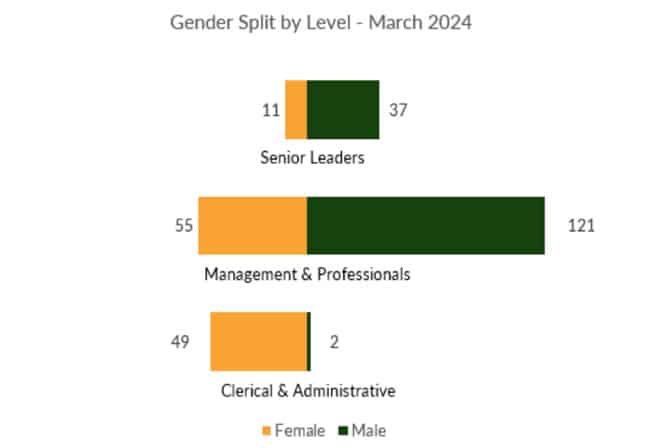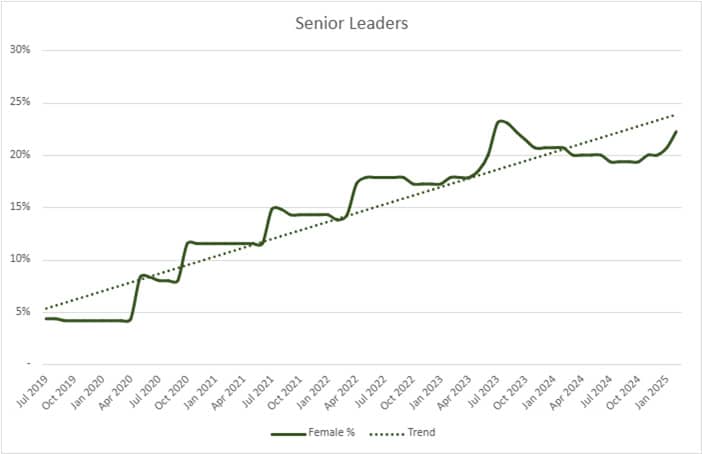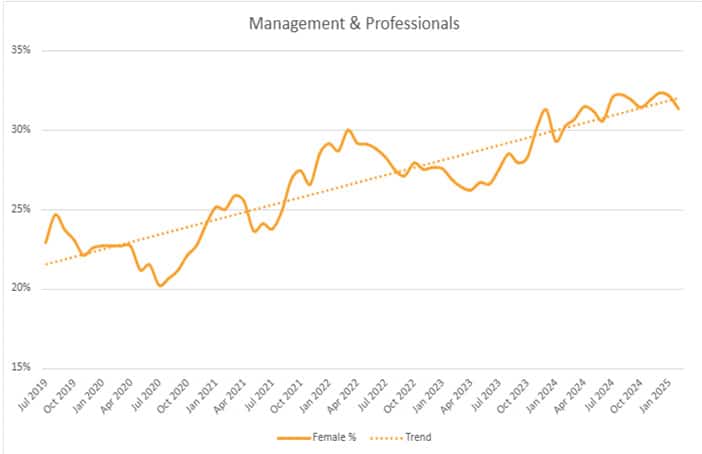Acumentis welcomes the introduction of
gender pay gap reporting in Australia.
Our commitment to diversity, inclusion, and equity is deeply ingrained in our guiding principles, specifically under the banners of “Embrace Equality” and “Support Our People.”
Recognising the significance of the gender pay gap, we are transparently sharing this report as a means to establish a benchmark and facilitate ongoing progress tracking. At the heart of
the matter, our pay gap arises from having more males than females across various roles and levels within our organisation.
It’s important to note that performance pay constitutes a substantial portion of the remuneration for many roles within our company, contributing to the overall reported pay gap. Acknowledging these factors enables us to comprehend the origins of the pay gap and empowers us to implement thoughtful initiatives aimed at narrowing this gap in the future. We are committed to fostering positive change and ensuring a more equitable workplace for all.
Legislative Requirements
The Workplace Gender Equality Act 2012 (the Act) requires non-public sector employers with 100 or more employees (relevant employers) to report annually to the Workplace Gender Equality Agency (WGEA) against standardized gender equality indicators.
The reporting process involves completing a workplace profile and a reporting questionnaire.
The gender equality indicators are designed to measure gender equality in the workplace, including areas such as leadership, gender composition of the workforce, and remuneration.
The Act does not require employers to report their action or progress towards meeting any particular target.
The WGEA publishes public report submitted by relevant employees on their website after removing personal and remuneration information.
The Workplace Gender Equality Amendment (Closing the Gender Pay Gap) Act 2023 requires WGEA to publish aggregate information for each relevant employer for each reporting period showing the employer’s gender pay gap and progress in achieving gender equality in relation to remuneration for the employer’s workforce.
The gender pay gap information for 2024 was published on the WGEA website in February 2025 and this report provides additional information to assist with understanding the information published by WGEA and also actions Acumentis is taking to address gender equality.

Gender Pay Gap – more than a number
We are proud of our ongoing commitment to closing the Gender Pay Gap as evidenced by our reduction
in our pay gap from 40.7% in the 22/23 reporting period to 35.9% in the 23/24 reporting period.
*Average total remuneration
Gender Pay Gap
21.7%
21.8%
Gender Pay Gap*
40.7%
35.9%
Gender Pay Gap
46%
35.9%
Whilst our gap is now equivalent to the real estate industry overall, our focus is on closing the gap. To be in line with the overall
national gap is one objective; a result closer to zero is another objective.
Our Gender
Pay Gap
We recognise that the gender pay gap is a crucial indicator, reflecting the disparity in the average total remuneration of men and women across all roles and seniority levels.
According to the measurement by WGEA, our overall gap stands at 35.9%, however the base salary gap is 23.6%.
Taking ownership of our situation, we acknowledge that the gender pay gap within our organisation is primarily influenced by variations in performance pay, which is tied to the level of fees generated by leaders, management, and professional staff. Additionally, the lower representation of females in roles with higher potential performance pay contributes to this imbalance.
We understand that the roots of gender pay gaps are deep-seated and intricate. However, we are committed to taking decisive actions that will yield the most significant potential impact in reducing this gap. It is our responsibility to address these issues head-on and work towards fostering a more equitable and inclusive environment.

| GENDER PAY GAPS | 22/23% | 23/24 % |
| All Managers | 16.6% | 13% |
| All Non Managers | 38.7% | 30.5% |
| Clerical & Administrative | -10.0% | -7.1% |
| All Employees – Total Remuneration | 40.7% | 35.9% |
| All Employees – Base Salary | 28.0% | 23.6% |
The gender pay gap at the senior leader level is being addressed via a focus on increasing the proportion of females holding these roles.
For professional staff, the gap is related to the level of fees written given our pay is weighted towards performance pay based on the level of fees written by each employee.
When we look at total remuneration as a percentage of fees written by gender, female professionals earn a higher percentage.
Whilst many of our female employees earn a higher percentage of fees written, overall their total remuneration may be lower than a male counterpart who writes higher total fees.
We are taking steps to ensure that female employees are given opportunities to write higher fees and to remove any potential impediments to achieving this.

Equality of Gender – Increased Female Representation
Acumentis has been successful in improving gender representation within senior leaders, management and professional roles:


Acumentis is focused on closing the gender pay gap via achieving equality of gender at all levels within our business via:
RECRUITMENT |
RETENTION |
PROGRESSION |
| We advertise all roles with reference to flexible & hybrid working | Flexible and part-time working is available to everyone | We provide sponsorship and mentoring across our pipeline of females to accelerate progression into senior roles |
| We ensure whenever possible we have a gender balanced interview panel and/or representatives trained in prevention of unconscious bias | We provide a range of benefits and support for parents and those returning to work from parental leave | We have structured career progression pathways with clear criteria and advancement opportunities for all employees, regardless of gender |
| Where we utilise external recruiters, we request gender balanced candidate lists | We invest in leadership training programs that specifically address gender bias and equip managers to be advocates for gender equality within their teams e.g. Future Women Change Makers Program | We conduct regular pay audits to identify and rectify any gender-based pay disparities among employees in similar roles with similar qualifications |
| We will deliver unconscious bias training for all leaders within our organisation to reduce any bias in our recruitment, interview and promotion processes | We will review and assess the criteria used for performance evaluations and promotions ensuring that they are fair, objective, and free from gender bias. | We are developing a pay equity strategy and action plan via our Gender Pay Gap Software – Equidi |
Our Commitment to
Closing the Gap
Acumentis continues to be committed to promoting diversity, equality, respect and inclusion. We recognise that diversity and inclusion benefits our profession and the community. Accordingly, Acumentis has and continues to commit to:
- Treating people with respect and dignity regardless of sex, sexuality, disability, age, race, ethnicity, religion, culture or other feature;
- Creating and fostering equality through a supportive and understanding environment for individuals to realise their maximum potential regardless of differences;
- Promoting and supporting a strong and fair profession comprising, accommodating, encouraging and respecting a diverse range of individuals and views.
Specifically in relation to the gender pay gap:
- Our pay gap exists as a result of greater male than female representation at different levels in the company. We will address this by working to remove the underlying causes and develop a workplace where all people can achieve their goals and progress through the organisation or grow in their current roles.
- Whilst we do not have formal targets for gender representation in leadership positions, we are committed to increasing participation of women in the workforce and specifically in leadership positions to provide diversity of opinions and beliefs
A word from the Managing Director & CEO
“Diversity is the mix of people in our organisation. Inclusion is getting this mix to work – creating an environment where a diversity of people are respected, connected, and progressing and contributing to our organisation’s success.
Therefore, as an organisation, if we wish to experience the benefits of diversity, we need to continue to cultivate not just a diverse workplace but importantly, an inclusive one.”

Timothy Rabbitt
Managing Director & CEO